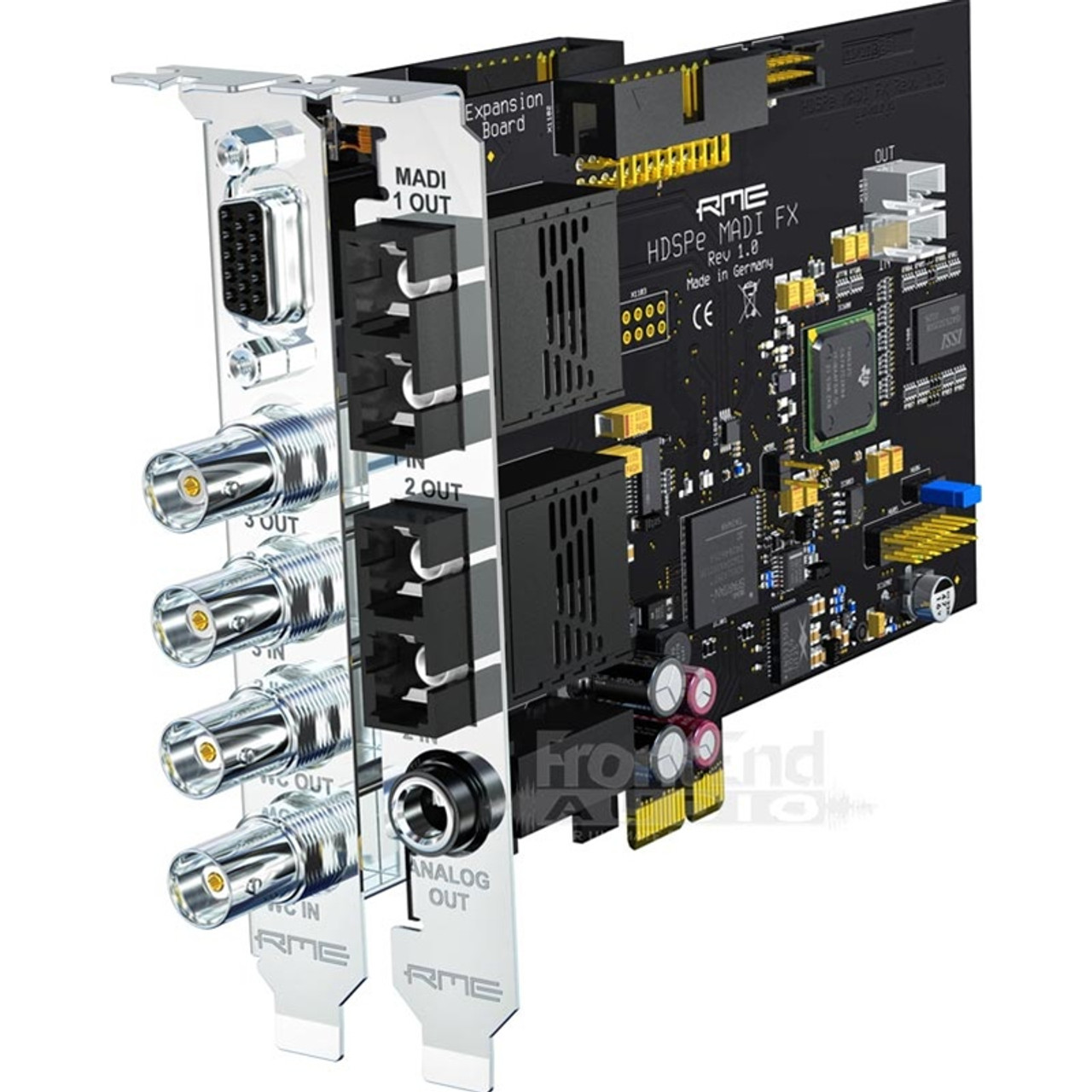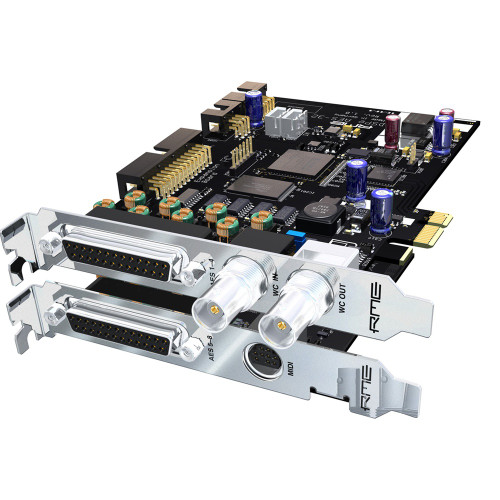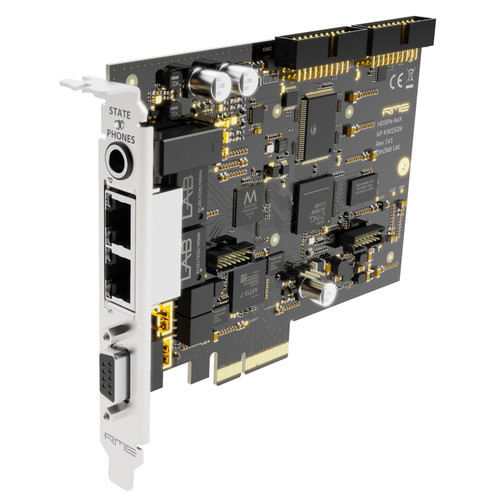The RME HDSPe MADI FX PCI Express Card is a unique audio system capable of transferring digital audio data directly into a computer, from any device equipped with a MADI interface. Based on the common professional AES/EBU standard, the HDSPe transmits 64 audio channels with a single line and embeds MIDI and RS232 signals invisibly into the data stream.
The RME HDSPe MADI FX PCI Express Card marks a new milestone both in the history of audio interface cards in the past two decades and within the long series of outstanding RME devices. Never before has such a high-performance multi-channel audio system existed.
The RME HDSPe MADI FX features 390 audio channels! Three MADI I/Os - two optical and one coaxial are accompanied by one AES/EBU I/O and one analog monitoring output. To complete the feature set, a Word Clock connection and four MIDI I/Os were added. The complete technology and connectivity are highly integrated into the smallest possible amount of space - typical for RME. Only one PCIe slot is required on the motherboard, plus one free slot opening on the case.
To guarantee RME's unique low latency performance with such a huge amount of audio channels, the RME HDPSe MADI FX introduces a newly developed modular Hammerfall Pro Audio Core. The high-tech core will process three times as many channels as the channel count of the previous MADI flagship, while actually reducing the system load and enabling ultra-low latencies down to 32 samples on modern computers.
A sophisticated new efficiency technology will automatically deactivate currently unused channels, so that they require no processing power or bandwidth. A simple stereo playback will not require any more performance than from a standard stereo audio card - despite the use of a professional multi-channel system with almost 400 channels.
The new core technology is accompanied by a special version of TotalMix FX, which allows using the enormous channel count in an efficient and practical manner. The addition of numerous performance optimizations ensures that the 4096-channel mixer of the MADI FX responds just as smoothly as its 1800-channel counterpart in the Fireface UFX. A new and faster DSP allows for a greater number of EQs and compressors.
An innovative new layout of TotalMix enables ergonomic handling of the enormous number of channels. A special option makes it possible to visually hide unused channels. Complete "Hide setups" can be saved at any time, and switched with a simple mouse click, for example between the channel view of the drum mix and the full band setup.
The 192 kHz RME effects engine allows latency-free monitoring with numerous effects like EQs, Compressors, Reverb, and Echo rendered directly on the hardware of the card, independent from the DAW software in use.
The integrated TotalMix matrix conveniently allows the use of the card as powerful MADI router. Unlike most other router solutions, each channel can be routed individually - even with separate level settings for each routing. The unparalleled flexibility of TotalMix can turn the most exotic applications into practical reality.
The RME's unique Seamless Redundancy Operation uses the cards 3 MADI receivers to provide professional users with state-of-the-art fail safe operation. In SRO mode the card operates as single MADI input device, recording up to 64 channels. As soon as the current input fails the audio data received from one of the other two inputs is used. The audio data is not interrupted when switching to another input and the card can use not only one, but two more sources for redundancy. No relocking and synchronization to a different clock source is required, and the interruption caused by the external failure is minimized to a few samples.
The card also features SteadyClock, RME's active jitter suppression and the unique professional meter and analysis toolbox DIGICheck - including EBU R128 metering - as well as nearly identical operation of the card under Windows and Mac OS.
Sonarworks and RME Colaboration
Thanks to the DSP in certain RME audio interfaces, a unique and powerful colaboration between RME and Sonarworks, brings new possibilities in monitoring calibration and audio reproduction. Certain RME interfaces are now compatible with the SoundID Reference calibration profile, allowing you to export it directly onto the DSP and eliminating the need to run the software in the background.
Compatible Interfaces include:
UFX III
UFX II
UFX+
UCX II
Fireface 802 FS
HDSPe MADI FX
MADIface XT II
If you own a perpetual license for Sonarworks’ SoundID Reference you can load your exported profile directly to these interfaces to run them via the interface's built in DSP - no longer needing to run the software in the background.
How does it works:
Step 1: Measure your set up
Measure and calibrate your studio speakers using the microphone provided by following the steps in the set-up guide.
Step 2: Choose your target mode
Choose your calibration Profile and correct for the Dolby Atmos Music curve, flat frequency response or create custom profiles.
Step 3: Export your Profile
Export up to 32 unique Profiles directly to RME interface’s internal memory, watch as your settings are automatically adjusted.
Step 4: You’re Now Ready to Mix
Sit back and enjoy a consistent translation of your audio no matter what format you are working in.
This gives you benefits in room correction, once only available with the likes of Genelec's GLM profiles being able to be stored on the Genelec SAM series monitors, but with this colaboration - you get the functionality with any monitoring system. Further this works for stereo and ATMOS (immersive audio) systems.
RME HDSPe MADI FX PCI Express Card Features
- All settings can be changed in real-time
- 8 available buffer sizes/latencies: 0.7 / 1.5 / 3 / 6 / 12 / 23 / 46 / 93 ms
- 100 channels 96 kHz/24 bit record/playback
- 52 channels 192 kHz/24 bit record/playback
- Automatic and intelligent master/slave clock control
- Word clock input and output
- TotalMix for latency-free submixes and perfect ASIO Direct Monitoring
- SyncAlign guarantees sample aligned and never swapping channels
- SyncCheck tests and reports the sync hronization status of input signals
- 1 x MIDI I/O, 16 channels high-speed MIDI
- DIGICheck DSP: Level meter in hardware, peak- and RMS calculation
- TotalMix: 4096 channel mixer with 46 bit internal resolution
- SteadyClock: Jitter-immune, super-stable digital clock
RME HDSPe MADI FX PCI Express Card Specifications
- 1-Lane PCI Express Endpoint Device: (no PCI Express to PCI Bridge), revision 1.1.
- Line Speed: 2.5 Gbps line speed
- Communication: Packet-Based Full-duplex Communication (up to 500 MB/s transfer rate)
- Settings: All settings changeable in real-time
- Control: Automatic and intelligent master/slave clock control
- Sync Sources: MADI coaxial, MADI optical, AES/EBU, word clock, internal
- Varipitch: by input signal or word clock
- Sample Rates: 44.1 kHz, 48 kHz, 88.2 kHz, 96 kHz, 176.4 kHz, 192 kHz, variable (Sync/word clock)
- Sample Rate Range: MADI: 32 kHz - 96 kHz, word clock: 27 kHz - 200 kHz
- Jitter: < 1 ns, internal and all inputs
- Jitter Sensitivity: PLL operates even at 100 ns Jitter without problems
- Comes With DIGICheck: the ultimate measurement, analysis and test tool
- Input Word Clock: Signal Adaptation Circuit (functional from 1.2 Vpp input signal), switchable termination
- Output Word Clock: BNC, low-impedance driver stage, 4 Vpp into 75 Ohms, short-circuit-proof
- MIDI Input and Output: via two 5-pin DIN jacks
- Stereo Monitor Output (Phones):
- Signal-to-Noise (DR): 110 dB RMS unweighted, 113 dBA @ 44.1 kHz
- Channel Separation: > 100 dB
- Output: 6.3 mm TRS
- Output Impedance: 75 Ohm
- Output Level at 0 dBFS: +13 dBu
- Connectivity:
- PCI Express Interface
- 194 input- / 196 output channels = 390 channels
- 3 x MADI I/O (2 x optical + 1 x coaxial)
- AES/EBU I/O (via breakout cable)
- 3 x virtual MIDI I/O over MADI
- 1 x MIDI I/O via 5-pin DIN (breakout cable)
- Stereo Analog Out
- Word Clock I/O
- TotalMix FX with 192 kHz effects engine
- Drivers:
- Windows 7 / Vista / XP SP2 (32 & 64 bit)
- Apple Mac OS X Intel (Core Audio), 10.6 or up
- Windows and Mac OS X drivers are completely identical in terms of features and functionality. Some features in DIGICheck are not yet available in the Mac version
RME HDSPe MADI FX PCI Express Card Includes
- HDSPe MADI FX PCI Express card
- HDSPe MADI FX BNC-X expansion board
- Quick Info guide
- RME Driver CD
- AES/MIDI breakout cable
- Expansion Board ribbon cable (20-conductor)
- Internal Sync cable (3-conductor)
1 Review Hide Reviews Show Reviews
-
Pricey, but worth it
Aug 20th 2013Fantastic card. A huge amount of I/O, super stable, integrated FX (great for "confidence reverb on a monitoring path) and extremely flexible routing. I have heard about some problems with PT compatibility but it seems to work great with PT11 running under windows even with all I/O enabled. If you're using multiple different models of converters you will have to account for different conversion latency, but this has been a minimal problem so far.
Write a Review















 Sign Up for exclusive sales and offers!
Sign Up for exclusive sales and offers!